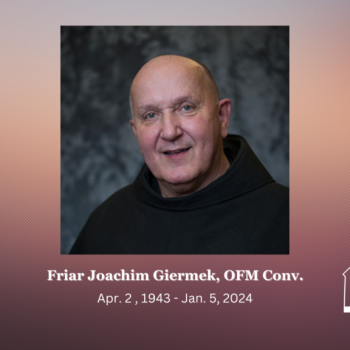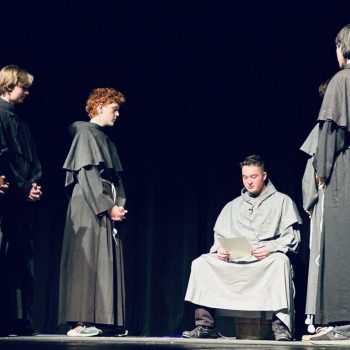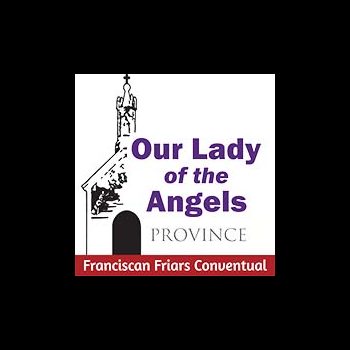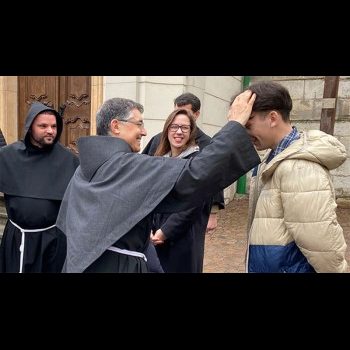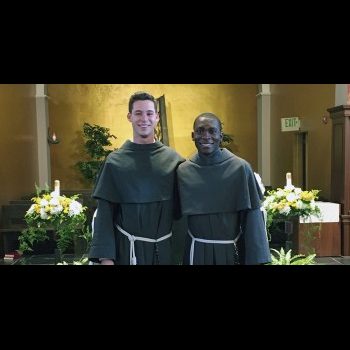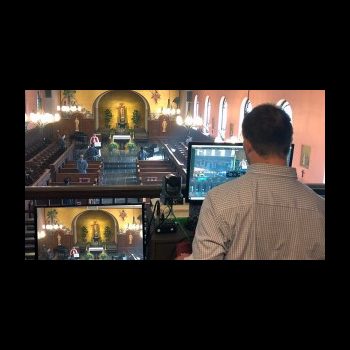ST. ANTHONY OF PADUA
 |
Ferdinand drives away a demon |
St. Anthony, whose baptismal name was Ferdinand, was born in Lisbon in 1195, the eldest son of an influential family. His parents had great plans for him, and so they arranged for a proper early education. They were thinking of an ecclesiastical or bureaucratic career, but Ferdinand disappointed them by choosing a life more directly dedicated to the service of the Lord.
He is known for his piety and fervor in prayer. In fact, one of the earliest legends concerning him is of how he was disturbed by a demon while he was praying, and how he chased that demon away by making the sign of the cross upon the floor.
 |
Ferdinand in Augustinian habit |
Religious and Priest
Ferdinand’s pious intentions brought him into more and more conflict with his family. They wanted him to be successful according to the standards of the world. They wanted him to further the good fortunes of his family. Ferdinand only wanted to respond to the call of the Lord.
When he was fifteen, after much prayer and reflection, he left his rich home and went to live in the Augustinian Abbey of St. Vincent on the outskirts of Lisbon.
The Canons Regular of St. Augustine, the religious order which he joined, have always been famous for their scholarly pursuits. It is to the Augustinians that the Saint is indebted for his intellectual formation which made him one of the most learned clerics in Europe at the beginning of the thirteenth century.
Ferdinand thought that he would find the Godly peace which he sought by fleeing the world and joining a religious order. Unfortunately, St. Vincent was too near to his home. Friends and relatives were always visiting him, bringing him gifts which embarrassed him and news of what was happening in their social world which disturbed him. He simply could not find any peace there, and his studies were suffering.
 |
Ferdinand meditating on the Franciscan Martyrs |
Finally, Ferdinand begged his superiors for a transfer to another abbey, and they sent him to the Augustinian Abbey of the Holy Cross in Coimbra (which at that time was the capital of Portugal). There he continued his studies and was ordained to the Priesthood when he was 25 years old.
A New Call
After his ordination, Ferdinand was placed in charge of hospitality in his abbey. It was in this responsibility that he first came in contact with the Franciscans Friars. In 1219 he met five followers of St. Francis who were on their way to Morocco to preach to the Muslims. He was strongly attracted by their simple Gospel life style.
Then in February of 1220, news arrived that his five Franciscan friends had been martyred in Morocco. Their remains had been gathered together and sent to Portugal where they were being venerated as relics of martyrs of the faith. The king ordered them to be placed in the Church of the Holy Cross in Coimbra.
 |
Anthony becoming a Franciscan |
Ferdinand meditated upon the heroic response of these Franciscans to the call to live the Gospel of our Lord Jesus Christ, a call that brought them to carry their crosses until death. He wanted a charismatic response to God’s call to leave everything and follow Him.
Ferdinand eventually obtained permission from his superiors to join the Franciscans. He was invested with the Franciscan habit and began to learn the teachings of their holy founder St. Francis.
With this new life style, he also took on a new name. He called himself Anthony, after the hermit St. Anthony of the desert to whom the Franciscan hermitage was dedicated.
 |
Anthony on the ship at sea |
From Africa To Assisi
Shortly thereafter, Anthony set off with another brother to die as martyrs in Morocco. He had barely arrived when he contracted a horrible fever which left him semiconscious for weeks. He did not even have the strength to stand up, let alone go into the market place to preach the Word of God. Anthony’s generous dream of serving the Lord with his words and his very life had been crushed. There was only one thing left to do: surrender to the will of God!
And so Anthony said farewell to his beloved Africa, and he set sail for Portugal. But even this choice would be challenged by the Lord. His ship encountered a terrible storm which blew it off course.
Finally, the ship was forced ashore on the island of Sicily. Weak and confused as to the direction that the Lord intended for him, Anthony traveled to Assisi where there was to be a great chapter of the friars. On the feast of Pentecost in 1221 thousands of friars gathered in Assisi from all over Europe in what has come to be known as the Chapter of Mats.
 |
Friars gathered together |
There Anthony listened to the teachings of St. Francis, and he was greatly consoled. As the friars disbursed to go home to their friaries, Anthony waited for someone to give him a sign of where he should go. Finally, the Provincial of Bologna, Friar Graziano, invited Anthony to follow him.
 |
Anthony preaching |
Plans never really work out the way think they will work out, for God’s ways are not our ways.
In only a short time, Anthony had traveled from Coimbra in Portugal to the shores of Morocco, then to Sicily, then to Assisi, and finally to a small hermitage in Montepaolo. There, at last, Anthony found the peace which he had sought for so long. He immersed himself in his Priestly service to the community as well as in the household tasks of cooking and cleaning.
But the Lord had other plans for him!
 |
Anthony preaching in public |
One day he was asked to attend the celebration of an Ordination to the Priesthood in the city of Forb. The preacher failed to arrive, and Friar Graziano, Anthony’s provincial, ordered him to preach whatever might come to mind. All were astounded when Anthony preached with both great learning and fervor. Because of this moment, his peaceful period of retreat in the hermitage had come to an end, for henceforth he would be called upon to preach near and far.
Anthony traveled throughout Northern Italy and Southern France, preaching especially in the areas that had been plagued by heresy. He combated abuses in the Church which had caused many to lose their faith.
He also combated heretical positions (e.g. rejection of creation as evil, rejection of Church authority and the sacraments) which confused the faithful. His most powerful weapon against these enemies was how he lived out the Gospel – by living what he preached he was able to confound heretics and edify Catholics.
The Light Shining in the Darkness
Once Anthony had traveled to the city of Rimini because it was a hotbed of heresy. The city leaders had ordered everyone to ignore him, so no one turned up for his homilies. Wherever Anthony went, he was greeted by silence.
Anthony walked along praying and reflecting upon what had happened. As he walked outside of the town, he came to the mouth of the Marecchia River where it flows into the Adriatic. There he began to address the crowds, not of people but of fish.
He called out, “Fish of the river and sea, listen to the Word of God because the heretics do not wish to hear it.” Suddenly there were thousands of fish, all pushing their heads through the surface of the water straining to hear Anthony’s words.
The people of Rimini, seeing this miracle, gathered to listen to Anthony. What began with simple interest in an extraordinary event turned into a passionate conviction that Anthony was speaking to their very hearts. They were so moved by Anthony’s words, by his call to conversion, that they abandoned their hardened positions and returned to the Church.
 |
Anthony preaching in public |
Becoming All Things to All People
One of the reasons why Anthony worked so hard to convert heretics was because he genuinely felt pity for them. He saw that they were depriving themselves of the most precious gift of the Eucharist, and he believed that no one could long survive without this spiritual nourishment.
One day, a heretic told Anthony that he would believe that Christ was truly present in the Eucharist only if his mule bowed down to it.
They established that the test should take place in three days. The heretic starved his mule for the next three days.
When the appointed time had arrived, Anthony stood off to one side with the Blessed Sacrament in his hands, while the heretic stood to the other side holding some food for the mule to eat. The mule ignored the fact that it was starving and it went over before Jesus and knelt down to adore the Blessed Sacrament.
There are many other miracles associated with Anthony’s ministry, but they should not distract our attention from the fact that most of Anthony’s ministry was performed in simple everyday ways. It was his fervent life style, his prayer, his gentleness, his humble use of his great learning that brought people to conversion.
 |
Anthony at his desk writing |
Anthony also ministered to those who were ministering to others, for he taught theology to the friars in Bologna, Montpellier, Toulouse and Padua. His work and writings he became a Doctor of the Church (he is one of thirty six).
Minister of Reconciliation
Anthony was likewise concerned about those who would not hear the consoling words of forgiveness heard in the Sacrament of Reconciliation. He would normally go directly from his preaching to spending long hours in the confessional. Often he could not find a chance to take a rest or even get a bite to eat until long after sunset.
Anthony had the wonderful gift in his preaching of being able to challenge people to conversion without making them feel resentful.
 |
Anthony reattaches the young man’s foot |
One time a young man confessed to kicking his mother. Anthony, horrified at the lack of respect that the young man had shown his mother, told him that anyone who would kick his father or mother should have his foot cut off.
Interpreting Anthony’s words literally, the young man went home and cut off his foot with an ax. Called by the man’s hysterical mother, Anthony came to the young man’s house. Imploring God’s help, Anthony miraculously reattached the man’s foot.
 |
Anthony and friars healing divisions |
“Peace and Goodness,” was a greeting often heard from the early Franciscans. Sadly, peace and goodness were all too often lacking in their society. Emperors opposed Popes, and Popes sent great armies against kings. The nobility opposed the prerogatives of the merchant class, and they both despised the poor. There was a sense of chaos, and people did not know where to turn. These chaotic divisions extended down to the very foundation of society.
Anthony, like St. Francis, fought the evils of hatred and division. The simple Gospel message that he proclaimed at that time was short – it was that we must create the Kingdom of God while we have the opportunity. His example of love and acceptance itself became a powerful call to conversion for everyone who heard him preach.
 |
A new born infant miraculously speaks |
Because many held him in high esteem, he was often called to reconcile families, political parties and cities. He called people to liberate themselves from their self-imposed imprisonment to selfishness, resentment and jealousy (above all: sin).
Here, too, we hear of legends which show the St. Anthony eating a spirit of family and social peace.
There is the story of how he caused a new born baby to speak in order to proclaim the innocence of his mother who had been unjustly accused of adultery by her jealous husband. Another time he healed a woman who had been mortally wounded by her jealous husband.
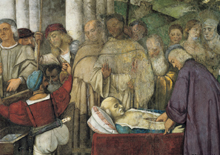 |
|
The miracle of the miser’s heart
|
Against Avarice
The 13th century marked a turning point in the economic history of Europe. Previous to this time, people generally depended upon subsistence farming to meet their needs. Each farm and each village were relatively autonomous which made trade difficult and dangerous. Cities were small and highly dependent upon their immediate environments for the necessities of life.
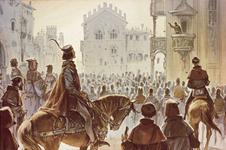 |
St. Anthony preaching in the public square |
The great pilgrimages of the late Middle Ages and the Crusades changed everything. Slowly people began to trade with more distant lands and to depend upon goods brought from outside of their communities. As trade developed, the cities grew. Simple barter was insufficient and the economy developed.
Along with trade and money, there was also a growth of malpractice business practices, e.g. usury (the lending of money at exorbitant rates of interest), debtors prisons, etc. Anthony, like the other friars, preached a detachment from the goods of this world. They condemned the exploitative business practices of their day, especially usury.
Once Anthony preached at the funeral of a money lender. He told his listeners that they should not bury his body in consecrated ground, for his soul was already suffering the torments of hell.
He said that the man’s heart was no longer in his body, but that the Gospel had been fulfilled, “For where your treasure is, there will be your heart (Mt 6,21; Lk 12,34).” They opened up the man’s side and found that his heart was missing, but they found it when they opened up his treasure chest.
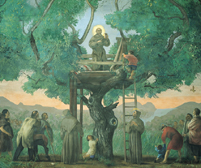 |
Anthony preaching from the walnut tree |
Defender of the Oppressed
Anthony always defended those who were powerless and incapable of defending themselves. He proclaimed the dignity of every person. He did this not only while he was preaching to the crowds, but also when he stood before those who were known to be cruel tyrants.
One of his contemporaries wrote, “Anthony, who had so avidly desired to die a martyr, did not give in to anyone, even if it might cost him his life; with enormous courage he resisted the tyranny of the mighty. He stood up to certain powerful figures so firmly that other preachers, even the most famous, trembled before his resolution and were smitten with fear.”
Far from closing himself behind the safe and tranquil walls of an abbey library as in his earlier years, Anthony now bore witness to the truth in the corridors of power and in the market places of his world (a life of a Franciscan Friars to be in the world but not of the world). He proved that the Gospel was alive and relevant to the people of his times.
The most famous story concerning his political courage involves a certain Ezzelino da Romano. Ezzelino belonged to the political party known as the Ghibellines. Both they and their opponents, the Guelphs, were famous for their conniving and blood-thirstiness, and Ezzelino was considered by all to be a master in the art of treachery. Ezzelino was holding certain Guelphs as prisoners, threatening to execute them. Anthony courageously stood before him and called him to conversion. He repented his ways, only to turn back to his old tricks after Anthony had left.
Anthony and the Christ Child
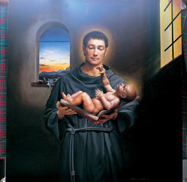 |
Anthony beholding the Christ Child |
By 1231, the many journeys he had made and the many illnesses he had suffered had taken their toll. Anthony was suffering from dropsy, and his strength had all but failed him. All throughout Lent of 1231 he preached to ever increasing crowds in Padua, but his preaching and the endless hours of confessions left him prostrate. Around this time, Anthony had a premonition of his approaching death.
The friars invited Anthony to go to Camposampiero, a town not far from Padua, so that he might recover his strength. Count Tiso had been one of the unscrupulous politicians seen in the previous account, but after hearing Anthony preach, he converted and donated a plot of land to the friars on which a friary was built.
The ground was damp at this time of year, and it aggravated Anthony’s illness. This problem was solved when the friars noticed that Anthony admired an immense walnut tree on the property. They told Tiso about it, and he had a small tree house built in the walnut tree for Anthony.
One night Count Tiso was passing by Anthony’s room when he was attracted by a powerful light. At first he thought that it must be a fire, and so he burst into the room. There he saw Anthony in ecstasy embracing the Infant Jesus. Anthony begged Tiso not to tell anyone what he had seen, and Tiso respected the his wishes until after he died.
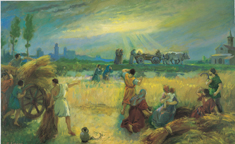 |
People look on as Anthony is carted to Padua |
I See My Lord
The care of Count Tiso and of the friars was not enough to bring Anthony back to health. On June 13, 1231, Anthony came down from his tree house to eat the noonday meal with the friars. They had scarcely begun when he collapsed into their arms. As the friars supported him, he whispered to them that he wished to be taken to Padua so that he might die there. He wanted to spend his last hours in the friary which he loved so much near the Church of Santa Maria.
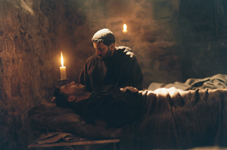 |
Anthony on his deathbed |
The friars put him on a cart and traveled toward Padua, but Anthony was already too weak to make it. As they approached a Poor Clare monastery in Arcella, a town close to Padua, they decided that it would be best to take him there.
After he was anointed by a priest, he intoned the hymn to the Blessed Virgin Mary, “0 Glorious Queen, exalted above the stars!”
The friars noticed that he was gazing attentively at something, and so they asked him what he saw. He responded, “I see my Lord.” Shortly after that he passed away.
The friars tried to keep Anthony’s death a secret lest his body be stolen, but almost immediately children were seen running through the streets of Padua calling out, “The Saint is dead. Friar Anthony is dead.”
He was only 36 years old, but he had traveled thousands of miles in his missions and had preached to countless thousands of the faithful.
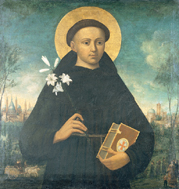 |
St. Anthony of Padua |
Everyone’s Saint
The friars carried the body from Arcella where he died to the Church of Santa Maria. That same evening miracles began to occur at the site of the tomb. The fame which Anthony had acquired during his life was redoubled in his death.
The bishop of Padua, and Pope Gregory IX, immediately began to promote his canonization. Anthony was so well known and his holiness so universally attested that the investigation lasted less than a year. On May 30, 1232, Pope Gregory canonized St. Anthony of Padua.
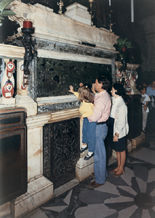 |
A family of pilgrims at the tomb of St. Anthony |
The friars, the people of Padua, and the ever increasing number of pilgrims who flocked to the tomb of the Saint all worked together to begin construction on a majestic basilica. In 1263 the friars transferred St. Anthony’s remains into the new church built in his honor. When the casket holding his body was opened to verify its contents, the tongue and the vocal cords of the Saint, the instruments with which he had glorified God in so many homilies, were found to be intact.
Today St. Anthony is truly a universal saint, respected and venerated even by non-Christians. He is especially known as the patron saint of the lost, for all throughout his life he restored things back to people who had lost them: for some it was their health, for others their hope, for still others their virtue, and for many their faith. Today, as in the 13th century, we call out, “St. Anthony, pray for us!”
And now it is your turn: What will St. Anthony do for you? What has St. Anthony done for you? How has St. Anthony brought you closer to Jesus?





